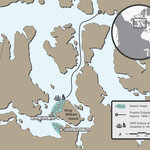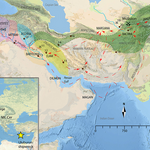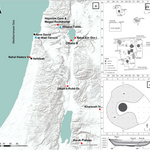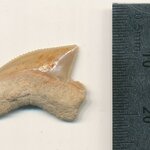If you ever get the chance to visit Turkey, I encourage you to do so. Like Civil War battlefields in the southern US, you can trip and stumble across something old - except in the case of Turkey it could be 2,000 years old.
Some sites are archaeological research and you can't just wander around like you can in Cappadocia. That is the case with the Göbekli Tepe temples in southern Turkey. It was inhabited in neolithic times and is ground zero in the culture wars over whether agriculture begat civilization or the other way around. Archaeological evidence shows they processed grain there, for…
Archaeology

In 1845, two ships under the command Captain John Franklin, the HMS Erebus and HMS Terror, left England on a voyage to chart the top of North America and a Northwest Passage that would connect the Pacific and Atlantic Oceans.
Like the interior of Africa and finding the source of the Nile, Great Britain was using some its imperial wealth to explore the unknown and a veteran skipper like Franklin wanted to be first to make the breakthrough across the north pole.
Their ships were state-of-the-art; interior heating and storage enough preserved food to last the 100-plus men for months at a…

Until Alfred the Great managed to isolate and contain invaders from Scandinavia, Lyminge, a monastery in Kent, was on the front line of long-running Viking hostility.
Lyminge endured repeated attacks for almost a century through effective defensive strategies, University of Reading archaeologists now say. Despite being in a region of Kent which bore the full brunt of Viking raids in the later 8th and early 9th centuries, they survived. rebuilt, and recovered more completely than historians previously thought.
The excavation at Lyminge, Kent. Credit: Dr. Gabor Thomas
During…

Archaeologists in northern Iraq, working on the Mashki and Adad gate sites in Mosul that were destroyed by Islamic State in 2016, recently uncovered 2,700-year-old Assyrian reliefs. Featuring war scenes and trees, these rock carvings add to the bounty of detailed stone panels excavated from the 1840s onwards, many of which are currently held in the British Museum. They stem from the ancient city of Nineveh which, for a time, was likely the most dazzling in the world.
There is evidence of occupation at the site already by 3,000 BC, an era known as the late Uruk period. But it was under King…

Inscriptions on the walls and crosses in a grotto first found by grave robbers in Lachish national park of the Judean lowlands west of Jerusalem have led archaeologists to conclude it was dedicated to Salome, associated with the birth of Jesus Christ in early Christian accounts. The Jewish burial chamber and ossuaries dating back to the Roman period became part of a Christian chapel during the Byzantine era until the region was captured by the Rashidun Caliphate in the middle of the 7th century.
The story pf Salome and her role as midwife at Christ's birth is in the Gospel of St James,…

A new study shows that supply chain cost increases coupled with inflation due to leaders just creating more currency are not new; they have been happening since ways to trade began.
Over 2,000 years ago, a ship carrying tons of rare metal sank in the Mediterranean Sea off the eastern shores of Uluburun — in present-day Turkey. It was located again in 1982, and since that time scientists have been studying the contents of the Uluburun shipwreck and one group believes small communities of highland pastoralists living in present-day Uzbekistan in Central Asia produced and supplied roughly one-…

A new analysis of human remains from ancient DNA of six individuals buried in Malawi, Tanzania and Zambia who lived between 18,000 and 5,000 years ago has produced the earliest DNA from the continent, and giving some insight into how early humans lived, traveled and even found love.
The study also reanalyzed published data from 28 individuals buried at sites across the continent, generating new and improved data for 15 of them. The dataset of DNA from ancient African foragers reveals a genetic legacy difficult to reconstruct from present-day people because of the many population…

Long before there were Israelites, Sumerians, or Egyptians in the world, the people living in Israel experienced a boom in food quantity and diversity, and a new study finds that the reason was climate change 23,000 years ago.
Ohalo II is a
submerged archaeological site on the southern tip of the Sea of Galilee in Israel and in it are preserved extensive evidence of human occupation about 23,000 years ago. Climate change was a given, the world was exiting its latest periodic ice age. Humans diversified their dietary habits. Some have posited that the changes in food were due to…

At an archaeological site in the City of David in Jerusalem, scholars have found an unexplained cache of fossilized shark teeth in an area where there should be none - nearly 40 miles from where they should have naturally occurred nearly 3,000 years ago, just after the death of King Solomon.
Since the teeth were from 66,000,000 years ago, Late Cretaceous, The answer would seem to be simple; they were fossilized, found, and then moved. But why? Did did the owners know they were ancient fossils?
The teeth were found buried in material used to fill in a basement before conversion to a large…

In 1946, with World War II over, archaeologists got back to work and over 10 years found discarded Hebrew Bible manuscripts in 12 Ein Feshkha Caves near the Dead Sea in the West Bank. Fragments o these "Dead Sea Scrolls" include the Apocrypha, except for the Book of Esther, which may not have survived over time.
No one knows who printed most older works, for the Christian Bible it was anonymous monks, and the Dead Sea Scrolls also contain no attribution, but there has been speculation about who may have written them. Some sought to at least connect them by handwriting.
A new analysis of…
